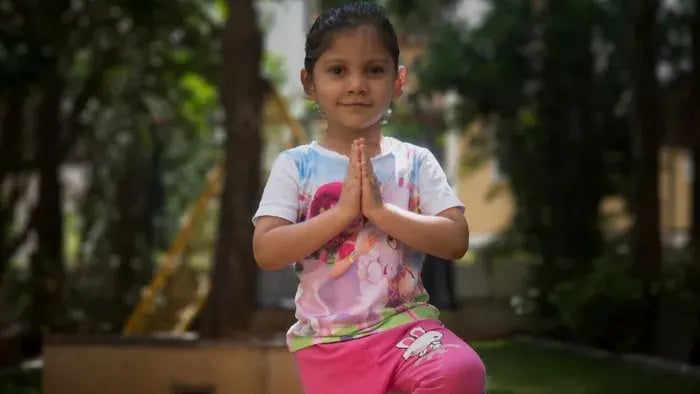- Number Counting
- Thought Counting
- Closing The Gates
- Sitting Still
- Feel The Sky
- Positive Affirmations
- Yoga Guided Meditation
Introduction
Meditation is a potent activity that focuses on the mind and cognition. According to a 2023 Cureus publication, paying attention to one's thoughts, breathing patterns, and bodily sensations can help channel one's energy in the right direction, leading to increased emotional stability and calmness. It focuses on various aspects, including breaths, awareness, the position of the spine, chanting powerful words, and more.
Relaxation techniques, such as meditation, can offer numerous benefits for children and teenagers. It can help regulate their emotions and make their transition from childhood to adulthood seamless. As per NLM, meditating regularly may reduce behavioral issues among kids and teenagers and may also help in combating stress.
7 Mindful Meditation Steps for Teens and Kids

Practicing meditation regularly may improve your child's sleep quality and enhance their attention. Moreover, it may also have benefits for their emotional and physical health. Here are some mindful meditation steps for your child who wants to start meditating regularly.
-
Number Counting
This is one of the best techniques for children who have just started practicing meditation. It may require your child to count from 1 to 10. With each number, they have to take a breath in and then breathe out. This process needs to be repeated until they begin to feel in control of their unwanted thoughts. As per WILEY, it is an activity that is generally done at the beginning of a meditation session to gain awareness.
-
Thought Counting
As per Breath Counting as a Measure of Sustained Attention in Mindfulness Meditation and Its Effect on Mood thought counting requires a child to sit in a relaxed position. You may give them some small balls, seeds, or even beads. The activity will require your child to put aside one object each as soon as they get a new thought. It can be practiced for a few minutes, and you will notice that the number of thoughts your child has in a minute or an hour decreases over time.
-
Closing The Gates

This is a meditation position that requires one to shut off all their senses. The method would require your child to cover their eyes, mouth, ears, and nose with their fingers. This is done so that the child has blocked all their sensory receptors except for the sense of touch. While doing so, you may guide your child to take some deep breaths and try their best to ignore the breathing sound by shutting their ears. After a few minutes of practicing this activity, you may ask your child to put their fingers down and listen to the sounds around them.
-
Sitting Still
If you're looking forward to building a bond between you and your child, then this technique, which requires patience and consistency, can help slow both of you down for a while and concentrate on each other. You can sit opposite your child with your back leaning against each other. Then you can take slow, synchronized breaths together. By being in contact with your back, both of you might be able to feel each other's breath.
-
Feel The Sky
Feel The Sky is a simple yet powerful activity that may bring your child closer to nature and enhance their visualization skills. To achieve the same effect, you may ask your child to close their eyes and take some deep breaths. Now, simultaneously, you may guide them to imagine a large, blue sky filled with white clouds and the chirps of birds. As they imagine, you can keep guiding them to think of more elements, such as a rainbow, the cloud passing through a mountain, and so much more. It is a fun activity to help your child focus on more creative thoughts and help them feel relaxed.
-
Positive Affirmations
For this, make your child sit in a comfortable position. Next, you can play some music in the background, such as the voice of the jungle or the calm pitter-patter of rain. Keep the volume low but audible. Try to dim the light by drawing the curtains and switching off the light bulbs. Now, you may have them repeat some positive affirmations, such as ‘I am happy’ or ‘I am confident’. Continue this for 15 to 25 minutes and encourage them to speak different types of positive affirmations during the process. According to a 2015 study published in Social Cognitive and Affective Neuroscience, positive affirmations may help reduce stress and negative feelings.
-
Yoga Guided Meditation

A yoga-guided meditation can be an effortless way of stimulating your child's mind and body. It may involve making your child do some simple pranayama and mudra. According to Frontiers, through guided voiceover, your child may be able to reflect on their thoughts and focus on more profound aspects. The intermix of yoga and meditation can have a soothing effect on your child.
Conclusion
Each of these meditation steps and techniques is easy to do and quite beneficial for your child. In addition to teaching them essential skills, such as patience and focus, your child may also find them extremely relaxing.
Pakhi writes with the belief that dessert isn’t just a dish—it’s a mood. Her work blends storytelling with tips, turning timeless treats and trendy bites into accessible moments of comfort, celebration, and creative expression.
The views expressed are that of the expert alone.
The information provided in this content is for informational purposes only and should not be considered a substitute for professional medical advice, diagnosis, or treatment. Always seek the advice of your physician or another qualified healthcare provider before making any significant changes to your diet, exercise, or medication routines.
















